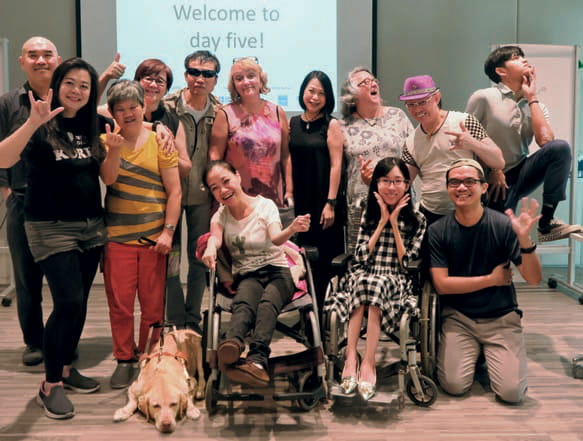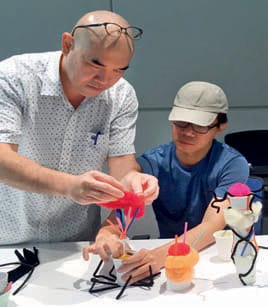Stories > Breaking Down the Barriers
Breaking Down the Barriers
A new art initiative aims to provide not only a conduit for disabled artists to express themselves but also to empower them to take on leadership roles in society.
BY Tan Hwee Hwee
or the disability arts sector to move forward, more differently-abled artists need to be leading the charge.” These were the words of executive director of Very Special Arts (VSA), Maureen Goh.
And it was with this aim that disabled arts facilitator Jo Verrent and leadership coach Sarah Pickthall from the UK came to conduct an unconventional training programme in Singapore for the very first time.
The five-day workshop, known as the SYNC Singapore Programme (SSP), is a leadership training programme designed for artists and arts managers with disabilities who wish to make a difference in the arts. Jointly organised by the British Council, National Arts Council, the Singapore International Foundation and VSA, it was held at the Enabling Village, a community-led space and initiative that serves and supports people with diverse abilities, in July 2019.
Verrent explains that she and Pickthall first decided to start SYNC in 2008 due to a fundamental lack of inclusivity.
“We both attended some UK-based ‘leadership training’ and found much of it to miss the mark for us. As disabled people, it either expected us to fit into moulds that were inaccessible to us, or it didn’t recognise the skills, talents and experience that we had by virtue of our lived experience. So we set up the course that we would want to go on.
“There are assumptions that disabled people cannot control how people treat us or the type of roles we might be offered – but this is not true,” explains Verrent. “We can often influence these things, if we better understand how people respond to us and how we can shape their responses.
“We also look at basic elements – such as the different leadership styles people might have and the different ways they are motivated – and dig deeper into how each of us is unique and lead in different ways.”

The five day workshop provided fresh perspectives in the field of art and disability.
CHALLENGES AND COMMON BARRIERS
The idea of bringing SYNC to Singapore was mooted by the British Council and VSA. SYNC has also been successfully held in Australia and South Korea with support from The Australia Council for the Arts and the British Council (in Korea). And Verrent acknowledges that taking the course around the world comes with its own set of challenges.
“Getting any programme funded is a complex task involving many agencies,” she says. “But I don’t necessarily see it as a ‘challenge’, as each agency involved brings something positive to the partnership.
“Disabled People Meet The Same Barriers Internationally. These Include Not Only Physical Barriers But Also Attitudinal Ones. The Assumption Is That We Are Not Good Enough And Can’t Do Things Rather Than The Recognition That Yes, We Might Have Access Requirements, But Once These Are Met, We Can Deliver At A High Level – Exactly The Same As Anyone Else.”
“A challenge implies overcoming something rather than finding ways to absorb and benefit from it. Building a group from scratch, with participants that don’t know each other; meeting their access requirements; supporting them as they grow in confidence – these all turn out to be incredibly rewarding.”

Malaysian deaf artist Anuar Lim (left) and Singaporean artist Alvan Yap exchanged knowledge during SSP.
Having to overcome the concept implied in the word “leadership” is, in itself, another test. “Leadership is a loaded word,” says Verrent. “People assume there is a single, specific ‘way’ to lead and can develop an aversion to the term.
“For us, it’s a broad word that covers a wide range of ways in which people can make impact and deliver change. By focusing on variety and individuality, we hope to overcome this.”
Verrent also notes that her experience in Singapore was similar to that of other countries. ”Disabled people meet the same barriers internationally,” she says. “These include not only physical barriers but also attitudinal ones. The assumption is that we are not good enough and can’t do things rather than the recognition that yes, we might have access requirements, but once these are met, we can deliver at a high level – exactly the same as anyone else.”
THRIVING ART SCENE FOR THE DISABLED
On a more positive note, Verrent says the disabled art scene in Singapore has been improving in the past few years. “I have been excited to see the Singaporean arts scene take on the issues of access and disability, particularly over the last few years,” she notes.
“For example, I was able to see the impact of a projec commissioned by Unlimited with the support of the British Council and the SIF a year or so back by playwright Kaite O’Reilly. It was called ‘And Suddenly I Disappear: The Singapore/UK 'd' Monologues’ which drew on interviews with disabled people from across Singapore and the UK. A number of Singaporean participants I met back then shared with me that their confidence and ambition have risen incredibly during this time as the country opens up new opportunities for disabled artists.”
Dawn-Joy Leong, an autistic multidisciplinary Singaporean artist, shares that one of the most important learnings she received from SSP was a glimpse into her own mindset.
“I discovered that there was a disparity between my innate style of leadership, in which I am most comfortable and effective, and the actual way I had been leading, and this dissonance could lead to burnout,” she recounts her experience.
“Enabling People With Disabilities Does Not End With A Five-day Workshop. There Is A Need For Continuous Sharing Of Information On Opportunities, Experiences, Both In Singapore And Other Parts Of The World, And Networks.”
Maureen Goh, Executive Director, Very Special Arts
Leong also acknowledged the valuable cross-cultural insight from the programme. “Jo and Sarah brought to the room a focused and disciplined mindset towards artistry combined with a sense of creative derring-do, which is sorely lacking in the Singapore context, hampered greatly by our kiasu mentality or the fear of losing out,” says Leong.
Attending the workshop as an organiser, Goh said it made her realise not only how much more access support was needed by people with disability but also their potential to collaborate and work together.
“Enabling people with disabilities does not end with a five-day workshop. There is a need for continuous sharing of information on opportunities, experiences, both in Singapore and networks,” she shares.

left to right: Katelijn Verstraete, Regional Director Arts & Creative Industries, British Council; Chua Ai Liang, Senior Director, Engagement and Participation, National Arts Council; Jean Tan, Executive Director, SIF; Sarah Pickthall, independent digital producer; Maureen Goh, Executive Director, Very Special Arts; Denise Phua, Mayor, Central Singapore CDC and Kenneth Kwok, Assistant Chief Executive, Planning and Engagement, National Arts, attended the opening of the workshop.
“There has been an increase in the number of works presented each year, the participation of individuals, and the organisations stepping up to support and generate greater awareness in terms of building inclusion through the arts and community events,” she adds.
For Anuar Lim, a Malaysian deaf artist and participant, SYNC marked his first time interacting with autistic people. As he was unable to read their lips, communication was undertaken using solely pen and paper.
“As a deaf person, being unable to speak and hear is a big challenge,” he explains. “I use pen and paper to communicate and always bring these with me. I also have a way of carrying out ‘total communication’ using techniques like writing, drawing, pointing at objects, technology like Whatsapp, gestures, body language and facial expressions.
The programme enhanced my knowledge by teaching me how to better communicate with the other participants at the event.”
In addition, Lim felt he has benefitted greatly from the opportunity to learn from fellow participants, such as award-winning Singaporean blind wire art sculptor Victor Tan. “Victor shared useful experiences with me, such as how to formulate strategies to upgrade my existing art business.” This, he says, has spurred him to conduct further study visits to the Lion City, to learn how disabled artists in Singapore “conduct production and marketing programmes”.
And despite the cultural similarities between Singapore and Malaysia, Lim noticed the difference in sign languages used between the two communities.
For Goh, the observations she made about Lim and the workshop were similarly useful. She noted, for instance, Malaysia’s abundance of creative talent and the eagerness of artists such as Lim to learn the best practices of other cultures while honing their own craft.
Emphasising the significance of diversity and collaboration in such initiatives, which help broaden the thought process, Verrent says she appreciates Lim’s participation in the group.
“It was brilliant having someone from Malaysia in the group to provide a fresh perspective. What works in one country can be adapted elsewhere, but we can’t make assumptions about what will and won’t work. Only people from that country, with deep cultural knowledge and appreciation, can comment on that. This is why I love running SYNC in different places – it means we can learn too. Surely, the point of any development programme is that everyone grows, including those running it.”
